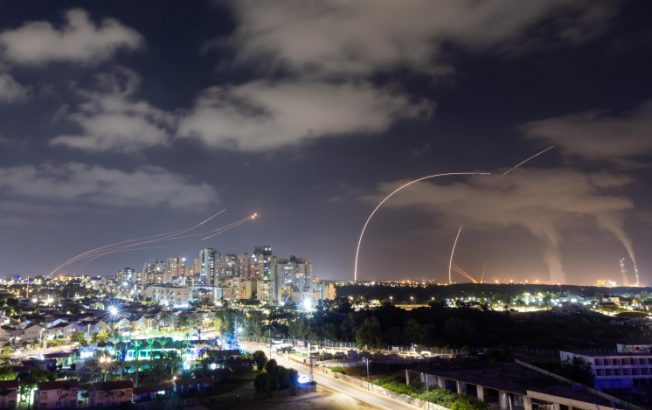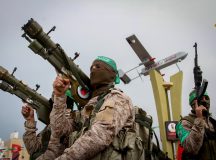Israel has established an integrated system spanning the entire country to address multiple threats, activating the different systems in an efficient and cost-effective manner and is connected to the American global missile-warning systems and to American defences. There is a widespread perception that Israel’s defence system has been successful in degrading the military capabilities of the country’s adversaries. Yet significant challenges remain from Iranian regional proxies.
In a recent BBC interview centering on Israel’s intelligence failure of 7 October, Alex Younger, the Former Chief of the Secret Intelligence Services, made the arresting claim that Israel had become complacent with over-reliance on security systems that provided ‘a false sense of security.’ Pointedly, he argued that Israel’s ‘Iron Dome’ missile defence system had ‘psychologically inured Israel to fear what would otherwise be uncertain and frightening.[1]’ During the fighting between Israel and Palestinian Islamic Jihad in 2022, Iron Dome had reportedly intercepted 97 percent of rockets fired from Gaza to Israel. The defence system has served as a comfort blanket for the Israeli public.
The successes of missile defence
During multiple rounds of warfare between Israel and the Palestinian militias in Gaza, Iron Dome had performed so successfully that there was no need for the government to send ground forces into the Strip. One notable exception was Operation Protective Edge of 2014. During that war (with missile defences reportedly intercepting around 90 per cent of rockets), the Netanyahu government launched a ground invasion because of attacks from Hamas tunnels which posed a more acute threat to the southern communities in Israel than the rockets which were devalued by Iron Dome.
Israel’s other missile systems have also played important roles. In the summer of 2019, after Israel and the US announced a successful series of tests of the Arrow 3 anti-missile system in Alaska, Israel’s prime minister Binyamin Netanyahu claimed: ‘Today Israel has the ability to act against ballistic missiles that could be launched against us from Iran or anywhere else.’ Recent developments in the region appeared to have vindicated Netanyahu’s claim. At the end of October, Israel used the Arrow 2 to intercept a long-range ballistic missile that was heading towards Israeli territory from Yemen. On 10 November, in the first ever use of the Arrow 3 system, Israel intercepted a missile heading for Eilat which was fired by the Houthi militia in Yemen. On 22 November, an IDF fighter plane intercepted a cruise missile that was fired towards Eilat.
The problem facing Israel, however, is that determined adversaries will always try to find ways to circumvent its technological edge and hurt the country. This was precisely what happened on 7 October when Hamas carried out its barbaric acts of terrorism against Israel’s communities bordering Gaza. This was the worst terrorist assault Israel had suffered in its 75-year history.
Caution advisable
Yet the missile threat to Israel is likely to become ever more acute. Uzi Rubin, a leading Israeli defence expert and a former director of Israel’s missile defence organisation has pointed out that it is easier to develop rocket and missile offence than rocket and missile defence. Iran has been working in close coordination with its proxies to produce a wide variety of rockets, missiles and drones that can saturate Israel’s missile and air defences. It would cost Iran a lot less to add ballistic missile warheads and decoys than it would for Israel to add anti-missile interceptors. The US has been cooperating with Israel in the development of a ground-based laser system known as Iron Beam, with a view to providing a more effective response to the range of new threats facing Israel, including cruise missiles and drones. However, Rubin warns that laser technology has its limitations. It has a limited range, a relatively low kill rate, it is sensitive to adverse weather and incurs high acquisition costs.
There is a growing danger that Israel could face an augmented missile threat from Iran’s other proxies, including Hezbollah, Shiite militias in Iraq and Syria as well as the Houthis in Yemen. Hezbollah has been attacking the IDF and Israel’s communities on the Northern border, and has hinted that it will escalate if Hamas is in danger of collapse in Gaza. Israeli military planners have therefore placed a growing emphasis on the development of multiple layers of defensive capabilities in facing missile and strategic threats from its enemies.
It is widely believed that Hezbollah possesses some 150,000 missiles and rockets, some of which can reach deep into Israel. In the event of a full-scale war, it will try to target vital strategic infrastructure such as military installations, troop concentrations, power grids and plants as well as the civilian population. In the event of a war on a number of fronts, Iran’s proxies have the means to fire thousands of missiles a day which may saturate Israel’s missile defences.
Policymakers thus face difficult decisions in prioritizing the location of its missile defence systems when facing a threat of this magnitude. As Yaakov Amidror, a former head of Israel’s National Security Council has emphasised, Israel cannot defend all locations at the same time – it has to decide whether to prioritise the allocation of defence systems in civilian areas or in military facilities, in a manner that allows it to prevail over its adversaries without risking the lives of its civilians.
Towards an integrated regional missile defence system?
Israel has established an integrated system spanning the entire country to address multiple threats, activating the different systems in an efficient and cost-effective manner. It is also connected to the American global missile-warning systems and to American defences. The US Strike Carriers that have been dispatched to the Middle East include the Aegis missile defence systems and radars which are designed to provide reassurance to Israel. Missile defence-capable Aegis ships are already part of the NATO system that has been deployed to protect European countries that are within range of Iranian missiles.
The USS Carney successfully intercepted three cruise missiles and several drones launched by Houthi forces in Yemen which were potentially heading for Israel. All this brings to mind the Bush administration’s decision in 1991 to send Patriot missile defences to Israel during the Gulf War in order to hold Israel close and persuade it to stay out of the conflict. The Patriots weren’t much use in stopping Saddam Hussein’s scud missiles during the Gulf War but they strengthened Israeli morale and helped Israel stayed out of the Gulf War as the US had hoped.
For successive US administrations, cooperation with Israel on missile defence – the development and funding of the Arrow 3 system, the funding of Iron Dome and now the dispatch of the Aegis missile defence system – is both a way to support Israel and also a means to try and prevent escalation. During his 2022 tour of the Middle East, President Biden spoke of his ambitions for the establishment of an integrated regional missile defence system which would include Israel. The US believes that the deployment of a network of radars, early warning systems, and interceptors would reinforce morale and confidence among those states in the region fearing the prospect of a nuclear-armed Iran (which would be most likely to deliver a nuclear weapon via a ballistic missile) and could help to lower the danger of a regional war
Nevertheless, such defences constitute a double-edged sword with countries such as Russia and Iran ever more determined to circumvent them. Vladimir Putin’s exaggerated fears of US missile defences resulted in his 2018 announcement to deploy new nuclear weapons systems including hypersonic glide vehicles that could elude defences.
This does not undermine missile defence’s importance. If enough rockets and missiles are shot down, they help to limit casualties and damage while giving victims of attacks strengthened morale that enables them to keep fighting. This is why Germany spent close to € 4BN on Israel’s Arrow 3 missile defence system in September. And amid growing fear of Russia’s missile threat, Finland decided to purchase David’s Sling in a deal worth € 317 M.
European countries spending vast sums on Israeli air defence systems clearly attests to a widespread perception that they have been successful in degrading the military capabilities of Israel’s adversaries. Rubin has long argued that while defences cannot provide a hermetic shield against ballistic missiles, even a partially successful missile shield can wrongfoot adversaries and complicate their planning – such as how the enhanced capabilities of Ukraine’s air defences have enabled it to stay in the fight against Russia. At a time when Israelis feel especially vulnerable, Israel’s air and missile defence systems remain critical in strengthening public resilience and fortitude.
[1] Iron Dome is designed to defend Israel from short-range missiles. Israel has also deployed the David’s Sling system to protect it from intermediate-range missiles in the hands of Hezbollah and possesses the Arrow 2 for shorter range ballistic missiles, and Arrow 3 for long-range missiles, particularly from Iran.



































